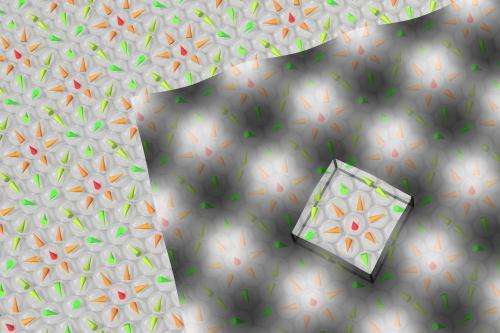Discovery of a new magnetic order

Physicists at Forschungszentrum Jülich and the universities of Kiel and Hamburg are the first to discover a regular lattice of stable magnetic skyrmions – radial spiral structures made up of atomic-scale spins – on a surface instead of in bulk materials. Such tiny formations could one day form the basis of a new generation of smaller and more efficient data storage units in the field of information technology.
The scientists discovered the magnetic spirals, each made up of just 15 atoms, in a one-atomic-layer of iron on iridium. They present their results in the current issue of the scientific journal Nature Physics.
The existence of magnetic skyrmions was already predicted over 20 years ago, but was first proven experimentally in 2009; a group of research scientists from the Technische Universität München (TUM) had identified lattices of magnetic vortices in manganese silicon in a weak magnetic field. Unlike these structures, the ones now discovered by physicists at Jülich, Kiel and Hamburg exist without an external magnetic field and are located on the surface of the materials examined, instead of inside them. Their diameter amounts to just a few atoms, making them at least one order of magnitude smaller than the skyrmions which have been identified to date.
"The magnetically-stable entities that we have discovered behave like particles and arrange themselves like atoms in a two-dimensional lattice", explains Prof. Stefan Blügel, Director at the Peter Grünberg Institute and the Institute for Advanced Simulation in Jülich. "This discovery is for us a dream come true". Already in 2007, the same scientific team had discovered a new type of magnetic order in a thin manganese film on tungsten and demonstrated the critical significance of the so-called Dzyaloshinskii-Moriya interaction for the formation of its wave-like structure. The same interaction is also necessary for the formation of the spiral-shaped skyrmions.
The scientists did not discover the skyrmion lattice at first attempt. Originally, they wanted to prepare a one-atomic layer of chromium on iridium, in order to investigate the presumed existence of a different magnetic state. As the experiments were unsuccessful, they then tried with other metals. Using spin-polarized scanning tunnelling microscopy in studies of iron on iridium at the University of Hamburg, the researchers noticed regular magnetic patterns that were not consistent with the crystalline structure of the metal surface. "We were sure straightaway that we had discovered skyrmions", says Blügel. Intricate calculations undertaken by the Jülich supercomputers subsequently proved him right.
The result is a model describing the formation of the spin alignment through a complex interplay of three interactions: the chiral Dzyaloshinskii-Moriya interaction, the conventional interaction between spins plus a non-linear interaction involving four spins. The model should help, in the future, to selectively influence magnetic structures on surfaces. "We are now planning to investigate the effect of electricity on skyrmions; how do the electron spins of an electric current "ride" the spirals, how do they influence resistance and how are the spirals affected?", says Blügel.
More information: "Spontaneous atomic-scale magnetic skyrmion lattice in two dimensions," Nature Physics, published online: 31.07.2011; DOI: 10.1038/NPHYS2045
Provided by Helmholtz Association of German Research Centres

















